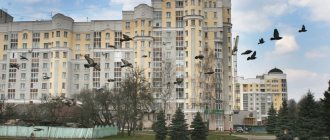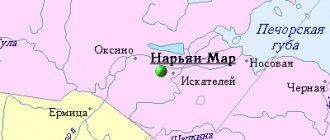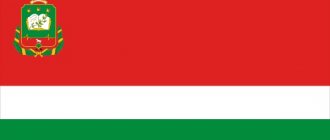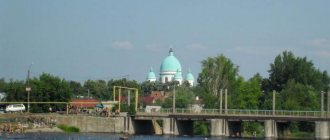| Michurinsk. In the center is the Elijah Temple |
Michurinsk
, a city in Russia, a science city, constitutes an urban district and is the administrative center of the Michurinsky district of the Tambov region, the cathedral city of the Michurin diocese. Located in the center of the European part of the country, in the western part of the Oka-Don (Tambov) plain, in the interfluve of the Volga and Don, on the right bank of the Lesnoy Voronezh River, 67 km northwest of Tambov and 69 km southeast of Lipetsk. A large junction of railway lines and roads. Population - 95.9 thousand (2015) [1].
- On the map: Yandex.Map, Google map
In 1627, Hieromonk Joseph founded a community of hermits in the nearby forests, which was renamed after the construction of the Holy Trinity Church in 1635 as the Trinity Monastery. In the autumn of the same 1635, by decree of Tsar Mikhail Feodorovich, governors Ivan Burkin and Mikhail Speshnev founded an earthen fortress to protect the southern borders of the Russian state from attacks by the Crimean Tatars and Nogais. Initially, the fortress was called the New City
, then
the New City on the Kozlov tract
, then
the New Kozlov City
, and finally simply
Kozlov
. According to one version, the name comes from the name of the Russian pioneer Semyon Kozlov, according to another - from the name of the area “Kozlovo tract”. From the middle of the 17th century it was a stronghold of defensive lines at the junction of the Belgorod and Simbirsk abatis lines.
In 1708, the city was assigned to the Azov province, in 1719 - to the Tambov province as part of the Azov (from 1725 - Voronezh) province. In the 18th century, Kozlov developed as a major trading center in an agricultural region. Since 1779 it has been a district town of the Tambov governorship, and in 1796 it was assigned to the Tambov province.
In the 19th century, trade in bread, livestock, rawhide, and cloth developed; there were handicrafts; processing of agricultural raw materials arose (mills, slaughterhouses, lard refineries, distilleries, tobacco factories, elevators); there were two iron foundries and a bell factory, and large railway workshops. In 1832, the artist A.D. Nadezhdin opened the third drawing and painting school in Russia in Kozlov. After a severe fire in 1865, the city was lined with brick houses; in the same year a railway from Moscow was built. Subsequently, the development of the railway network contributed to the growth of trade. By the end of the 19th century, the central part of the city had formed into a single historical and architectural complex.
On February 23, 1932 the city was named Michurinsk
in honor of the scientist-breeder I.V. Michurin, who lived and worked there since 1872.
In 1995, the workers' settlement of Kochetovka
. Thanks to a well-developed education system (an agricultural university, a pedagogical institute, several branches of higher educational institutions in other cities), on November 4, 2003, the city was awarded the status of a science city of the Russian Federation.
Statistics
- 1856 - 20.6 thousand people, 9 churches, 2316 houses, 348 shops
- 1897 - 40.3 thousand people
- beginning V. - 17 churches, 5 male and 2 female primary schools, 2 primary schools, a painting and drawing school, 2 shelters, 2 almshouses
- 1913 - 45.8 thousand people
- 1931 - 62.7 thousand people
- 1962 - 85 thousand people
- 1989 - 109.1 thousand people
- 2003 - 96.1 thousand people
general information
The ordinary provincial town of Michurinsk is located 73 km northwest of the regional center - Tambov. The second settlement in the region in terms of economic and cultural potential. The administrative center of the district of the same name, which it is not part of, is a city of regional subordination. In 2003, it was awarded the status of a science city of the Russian Federation. The population in 2021 was 93,330 people.
Where is Michurinsk located? In the central European part of Russia, between the Volga and Don rivers, on the right bank of the Lesnoy Voronezh river. A major transport hub in the region, through which the Caspian federal highway and the Moscow-Volgograd road pass. There are four South Eastern Railway stations in the city.
The foundation of the fort
On September 5, 1635, governors I. Birkin and M. Speshnev founded a small fortress to protect the southern borders of the Russian state from attacks by nomadic Tatars. Now the day of the city of Michurinsk is celebrated on September 22. Since the middle of the 17th century, it was a reliable stronghold on the defensive line at the junction of the Tambov and Belgorod borders, which more than once repelled attacks by nomads.
The area where Michurinsk is located has long been attractive to runaway peasants from more populated regions of the country. This is indicated, for example, by the complaint of the landowner Ivan Bobrishchev-Pushkin about the flight of serfs from his Don estate to the Kozlovsky district.
At first, the fortified point was called the “New City”, then the New City on the Kozlov Urochishche” and the “New Kozlov City”, which was gradually shortened to Kozlov. There are several generally accepted theories about the origin of the toponym. According to one of them, the city is named after the first inhabitant of the settlement, Semyon Kozlov. According to the second from the name “Kozlovo tract”. In 1932, it was renamed Michurin, in honor of the scientist-breeder I.V. Michurin, during his lifetime.
Michurinsk
Founding of the city, Kozlov
In 1635, Tsar Mikhail Fedorovich signed a decree on the creation of a new fortress, the main purpose of which was the defense of Ryazan from the Nogai and Crimean Tatars. The location for the fortress was chosen by governors Mikhail Speshnev and Ivan Birkin. The governors chose a small plot of land on the banks of the Lesnoy Voronezh River. Construction of the fortification began. The place was chosen well, but there was still one drawback. Despite the presence of a river not far from the future fortress, the fortification was in dire need of water, as it was located on a high hill. Carrying water to the fortress was extremely inconvenient. Meanwhile, the founding governors could not find specialists in digging wells, which they wrote to the king about.
The name of the fortress changed several times. At first it was called New City. This name must have been too common, since it was soon transformed into the New City on the Kozlov tract. Not far from the construction site there was land that belonged to the Kozlov family and was called a tract. However, this name turned out to be too long, and over time the city began to be called simply Kozlov.
In 1659, a shipyard was built near Kozlov, specializing in the construction of military ships. The ships built at this shipyard took part in the Crimean and Azov campaigns. However, the basis of Kozlov’s economy was still not the construction of ships, but trade. The city quickly gained fame as a shopping center. Traders from the settlements closest to Kozlov came here. The goods were very diverse: from agricultural products to Elton salt. Handicraft production was also considered a profitable activity. One of the city's thriving trades was prasolstvo. Prasols were people who bought cattle for next to nothing from nomads and subsequently resold them at a large markup. Kozlov became a place for resale of livestock for prasols. Every year several fairs were held in the city, lasting from 2 to 6 days.
In 1779, Kozlov became a district town in the Tambov province. Before the city came under the control of Tambov, it belonged first to the Voronezh and then to the Azov provinces. Initially, all the buildings of the city were wooden. But in 1865 there was a fire in Kozlov. Most of the buildings were destroyed in the fire. After this, the construction of brick houses began in the city. The architecture of Kozlov is unique. There is even such a thing as “Michurinsky style”. This style consists in the fact that all wooden houses in the city have mezzanines. They are even added to new wooden houses. For residents of other Russian cities, this looks very unusual.
In the “List of populated places of the Tambov province” for 1862, Michurinsk is listed as a district town of the Kozlov province near the Lesnoy Voronezh River and the Kamenka River, 65 1/2 versts from the provincial city of Tambov and 1,059 versts from St. Petersburg. The city was divided into 9 settlements: Streletskaya, Raznochinskaya, Podgornaya, Malorossiyanskaya, Starcheskaya, Storozhevaya, Pushkarskaya, Pokrovskaya and Yamskaya. Each of the settlements had one church. In Kozlov there were 2,328 houses and 22,348 residents of both sexes - 10,954 males and 11,394 females. Indicated are 9 Orthodox churches, 3 schools (district, parish and rural), 3 fairs, markets on Mondays, Wednesdays and Fridays, a postal station, 51 factories: 17 lard factories, 2 soap factories, 1 tannery, 4 candle making plants, 1 brewery factory, 18 brick factories, 5 tiled and 3 wax candles.
According to the same document, Kozlovsky district was divided into 2 camps. In the 1st camp, excluding cities, there were 14,631 households with a population of 122,565 people (60,906 males and 61,659 females), in the 2nd camp there were 9,196 households, population - 75,650 people (37,627 males and 38 023 female). In total, there are 454 populated areas in the Kozlovsky district, of which 65 villages with more than 100 households, the largest settlement is the village of Malye Pupki (Kazinka) with 863 households. More than 1,000 people lived in 59 villages of the district, the most populated was the village of Churyukovo with a population of 4,799 people. 99.6% of the county's residents were Russian.
According to information from 1862, Kozlov ranked first among the cities of the Tambov province in terms of trade development. The total volume of trade turnover in the city was 5,000,000 rubles. Bread in grain (mainly rye and oats) was sent mainly to Moscow and the Morshanskaya pier; cattle were also driven to the capitals, “but a huge amount of it goes to slaughter for rendering lard.”
In 1866, Kozlov was connected to Ryazan by railway. The sponsor of the construction was a joint-stock company created by Pavel Von-Derviz. The construction site of the road was an ancient horse-drawn route that connected the southern regions of the country with Moscow. The road had a positive impact on the economy of Kozlov and began to generate income from the first days of its existence. In 1870, a second railway was built. One railway line could not cope with the huge amount of cargo arriving in and out of the city. The railway company built a dead-end station. The arrival of the railway in the city inevitably led to an increase in the number of jobs. Car repair workshops were built next to the depot. In addition, a specialized person was needed to work at the station. The work of railway workers was paid relatively highly. People who wanted to work on the railway began to come to Kozlov. The number of city residents has increased several times.
The management of the Kozlovskaya Railway spared no expense for improvements and innovations. Steam locomotives, for example, were purchased from Germany. At that time, the railway had just appeared in Russia, which meant that there were practically no factories for the production of the corresponding transport. The locomotive repair workshops were also equipped with the latest technology. All equipment was manufactured at the Bromley brothers' mechanical works. The repair shops eventually turned into a steam locomotive repair plant. At first, the plant was engaged exclusively in the repair of steam locomotives belonging to the Ryazan Railway. After the revolution, all private property was nationalized, and the plant began to repair steam locomotives of all the surrounding railways. With the advent of railway communication, not only trade, but also industry developed in the city. A huge number of new enterprises appeared in Kozlov, such as a bell foundry, tobacco, lard-making and other factories.
Revolutionary movement in Kozlov
Residents of Kozlov took an active part in the revolution. Revolutionaries appeared here back in 1905 after the infamous Bloody Resurrection. On January 17, local telegraph operators staged a rally to protest the inhumane execution of unarmed people. After some time, railway workers joined the telegraph operators, stopping the work of the local railway. The protesters demanded a reduction in the working day to 8 hours, an increase in salaries and the abolition of some fines. Supporters of the revolution managed to organize a strike at local industrial enterprises for a fairly significant period (from October 10 to October 24, 1905). Workers left their jobs and marched, singing revolutionary songs.
The second major strike took place in the city during the Moscow uprisings. The authorities were concerned, since the city was considered the most revolutionary-minded settlement in the Tambov province. On December 10, a punitive detachment arrived in Kozlov. Posters were posted throughout the city calling for an immediate end to the strike and a return to work. The “peacekeepers” demanded that the instigators and leaders be handed over to the authorities. Only numerous threats and promises of reprisals were able to stop the strike. However, the threats from the authorities did not pacify the people for long.
12 years after Bloody Sunday, news of the February Revolution came to the city. The change of power became known in early March. The city residents organized a big celebration. The police were disarmed. Prisoners were released from prison. An executive committee begins to operate in the city. The Bolsheviks were represented in the minority in the first bodies of Soviet power. However, this did not prevent them from enjoying the trust of the city residents. A new printed publication appeared, called “The Soldier and the Worker.” It was through this publication that local Bolsheviks carried out their propaganda.
Kozlov's Bolshevik organization becomes the center of Bolshevism throughout the province. The Moscow leadership of the Central Committee of the RSDLP (b) decided to hold a provincial conference in this city. The Bolshevik conference was held in the editorial office of the newspaper “Soldier and Worker”. Today this building houses a music school. When news of the uprising arrived from Petrograd at the end of October 1917, the Council of Workers' and Soldiers' Deputies was convened in the city. The crowded hall heard the news that Bolshevik power had finally been established in Petrograd. The meeting was organized in the building where the 1st clinic is located today.
After the revolution, Michurinsk
Kozlov’s story is directly related to the man who appeared in the city in the early years of the railway’s development. His name was Ivan Michurin. The young man began his working career at the age of seventeen. The railway, where he was forced to work, meant nothing to Michurin. Since childhood, he was only interested in plants. Ivan dreamed of his own garden, where he could grow whatever he wanted.
Michurin’s least favorite job was useful only in that it brought good income and gave him the opportunity to travel around the Ryazan province. During his travels, Michurin observed plants in all corners of his native land. Ivan had the opportunity to make acquaintances with gardeners from various gardening farms. These people taught him how to care for plants. When Michurin accumulated a significant amount of money, he was able to purchase a house with a large garden plot. His dream of a garden has finally come true. However, very soon the land he had was not enough for Ivan, and he moved. Thus, Michurin changed his place of residence several times. Michurin's scientific activities gradually attracted the attention of city residents. In gratitude for the hard work, the residents of Kozlov decided to name their city after the former railway worker. The renaming took place during Michurin’s lifetime in 1932.
During the Great Patriotic War, most of the Michurinites went to the front as volunteers. In total, about fifty thousand city residents went to the front. Two regimental divisions were formed in Michurinsk: the 331st and 161st. The soldiers of these divisions took part in the largest battles for the fatherland.
Modern Michurinsk is a city of regional subordination. It is the center of the Michurinsky district. The city is considered the second in terms of population and other indicators after the capital of the region - Tambov. In 2003, the city was awarded the status of a science city according to the decree of the President of the Russian Federation. Michurinsk became the first city in the Russian Federation to receive such status in the agricultural sector. In 2010, the city began construction of the Green Valley agrotechnopark, the activities of which, according to the terms of the project, should be focused on growing environmentally friendly agricultural products. The All-Russian Scientific Research Institute of Horticulture named after I.V. Michurin is located in Michurinsk.
Development of the region
Around the beginning of the 18th century, Kozlov began to develop as a regional center, which concentrated trade in the region's agricultural products. Trade in wheat, cattle, salt, rawhide, cloth and silk flourished in the small town. The first handicrafts also appeared, which later grew into full-fledged production. In the 19th century, many enterprises related to the processing of agricultural raw materials began operating: elevators, slaughterhouses, mills, tobacco factories, lard refineries and distilleries.
In the twentieth century, several small metallurgical plants operated in Kozlov (Tambov region). A significant contribution to the development of the city was made by the construction of the railway, which operated large railway workshops (now a locomotive repair plant). Around the same time, the architectural appearance of the historical part of the city took shape, which has been preserved to this day.
A little history
In 1932, the city of Kozlov was renamed Michurinsk. It received this name in honor of the famous Michurin, who lived his whole life in this city and transformed his own nursery of fruit and berry plants into an agro-industrial research center that has no analogues in the whole world. Ivan Vladimirovich is the creator of many fruit and berry crops. Michurin’s case is still ongoing, as a result of which the city was given the status of a science city. In the Russian agro-industrial complex, only Michurinsk has it.
Plant Breeding Center
The city of Kozlov became widely known already in Soviet times thanks to the active propaganda of the activities of Ivan Vladimirovich Michurin. Who moved here in 1872 and never left. Using his own funds, he began to develop new varieties of garden crops. By 1917, his nursery grew more than 900 species of plants from around the world.
The scientist himself expressed a desire to work for the new government. In 1918, his nursery was nationalized, Michurin himself became the manager and received funding to continue the work. In 1934, a genetic laboratory was organized, which later grew into the Institute of Genetics and Selection of Fruit Plants, named after him.
Religion
Even before the founding of the city, the Trinity Monastery for men was born here, and in 1641 the women’s Ilyinsky Monastery was built in the new fortress. Among the churches of the 18th-19th centuries, the Ilyinskaya Church (1781, presumably designed by the architect V.V. Rastrelli) and the Bogolyubsky Cathedral (1873, architect K.A. Ton, a reduced and simplified likeness of the Moscow Cathedral of Christ the Savior) stand out.
From 1869 to 1937, the Kozlov (Michurin) vicariate of the Tambov diocese operated. Since December 26, 2012, the city has become the cathedral center of the independent Michurin diocese as part of the Tambov Metropolis.
The Saints
Monasteries
Temples
Source
Science City
The region where Michurinsk is located has been a recognized center of Russian gardening since pre-revolutionary times. The city is home to several scientific and educational institutions dealing with breeding, genetics and horticulture. In 2003, it was awarded the status of a science city with specialization in scientific and innovative activities in the agricultural sector. Institutes and high-tech enterprises were supposed to engage in fundamental research in the field of genetics, breeding, and biotechnology of berry, fruit and vegetable crops; development of experimental technologies for the production of fruits and vegetables; development of various types of plant food products, including special and health products.
In 2010, by decree, the government decided to create the Green Valley agro-industrial technology park in Michurinsk, which specializes in the cultivation and processing of agricultural raw materials. In addition, it is intended to produce plant-based foods for a healthy diet with genetically specified properties.









